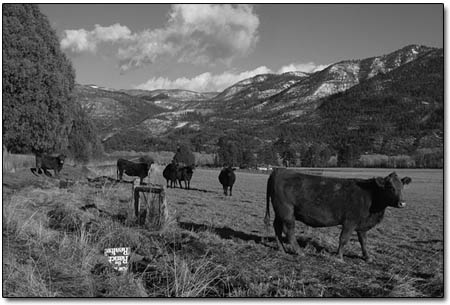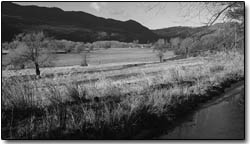|
Landowners capitalize on tax credit opportunity
by Will Sands
 |
A herd of cattle waits for
nightfall Monday evening along Highway 550, north of Hermosa.
Increasing amounts of open space like this have been put under
conservation easements this year, thanks to the Colorado Conservation
Tax Credit, a unique program
that allows landowners to use the tax credit against outstanding
tax or sell it for cash./Photo by Todd Newcomer. |
Cliff Schmid’s family has ranched on the Wells Champlin
Ranch in southeast La Plata County for five generations. Last
year, he and his wife Caryl voluntarily took steps to prevent
their property from ever being subdivided or developed when they
donated a conservation easement to the La Plata Open Space Conservancy.
The easement ensured that 112 acres of pasture always remain as
land dedicated to farming and ranching.
Interestingly, the Schmids’ operation has gained rather
than lost value because of the move. The easement resulted in
a tax benefit called the “Colorado Conservation Tax Credit.”
The first of its kind in the nation, the credit can be used against
existing taxes or sold to another taxpayer to generate cash. The
Schmids sold their credit and used the proceeds to buy 80 adjoining
acres and expand their operation. Last month, they put this property
in another conservation easement and again are leveraging the
tax credit to buy another adjoining parcel.
“We feel it is beneficial to everyone to protect this country’s
open space, especially agricultural land, and the greatest protection
tool so far has been the conservation easement,” Cliff Schmid
said.
 |
| Icy irrigation water passes
through Animas Valley grassland near County Road 250 on Monday
evening. Local land conservation groups are reporting that
2003 was a strong year for preserving open space in La Plata
County./Photo by Todd Newcomer. |
A record year
The Schmids are not alone in La Plata County. In spite of the
recent swell of growth and development, there also has been a
corresponding push to preserve threatened lands. With help from
the State of Colorado tax credit, which was enhanced this year,
local open space preservation has surged forward. Because of cases
like the Schmids’, local open space advocates are looking
back on 2003 as one of their strongest ever.
“We’ve already done 19 projects in a year’s
time, and we’re not quite done yet,” Kathy Roser,
executive director of the La Plata Open Space Conservancy, said.
“I think we’re going to have a record year 85 . We
haven’t protected as much area as some other years, but
we’ve had more projects than most other years.”
At this time, the La Plata Open Space Conservancy’s inventory
of protected lands includes 102 parcels and more than 14,300 acres
of farm and ranch land, wildlife habitat, scenic open space, recreational
land and archaeological sites in southwest Colorado. Over the
past year, the conservancy has helped people ranging from ranchers
like the Schmids to new homeowners on the Steward Ranch development
up Lightner Creek, where it accepted 11 easements. In that case,
the developer encouraged buyers to donate 4
conservation easements on their property and prohibit future
subdivision. The preserved chunks range in size from 36 to 120
acres.
Worthy of protection
Tami Graham is the land trust coordinator for the Animas Conservancy,
which was founded in 2000 with the intent of preserving 10,000
acres of the Animas River watershed. Graham said that in the last
12 months, she has seen a 50 percent jump in both the amount of
interest and the resulting number of easements. Like Roser, she
credited the enhanced tax credit.
“We’re definitely seeing a spike because of the tax
credits,” she said. “It’s gotten to a place
where we’ve got to be sure we’re not just providing
a tax credit for somebody. We’ve got to make sure we’re
protecting land that’s worthy of protection.”
In the year 2001, Colorado became a national leader when it created
a conservation tax credit. In January of this year, the state
one-upped itself by increasing the amount a landowner can claim
from $100,000 to $260,000.
“That’s a big chunk of cash, particularly for people
who are making $20,000 a year on the farm,” Roser said.
Despite the incentive, Graham explained that one of her group’s
challenges still lies with landowner education. “A big stumbling
block that we find is educating owners of agricultural operations
about conservation easements and showing them that we’re
not a quasi-governmental group looking to take over their property,”
she said. “There’s a lot of misinformation about conservation
easements, and there’s a perception that there’s a
conflict between private property rights and what conservation
easements do.”
Glimmer of hope
On the contrary, Graham said that conservation easements allow
people like the Schmids to not only retain and improve their way
of life, but continue to leave a lasting legacy for the entire
county.
“A lot of landowners have an affinity for their property
and have worked it for generations,” Graham said. “A
conservation easement allows them to leave a legacy of protecting
that property.”
And if that property is not protected, it will likely become
something other than open space, according to Roser. “It’s
pretty hard to make a living on any farm and on small farms in
particular,” she said. “But there’s quite a
bit of farmland out there, and if it’s not snapped up quickly,
it will become houses.”
With a banner year for open space preservation behind them, Roser
and Graham are also looking at full plates for 2004. “It’s
huge right now,” Roser said. “We’ll be closing
on three more projects before the end of the year and at least
two more in January. We have a list of about 50 or 60 projects
we’re working on right now.”
Graham said there is hope, but that La Plata County still faces
an uphill climb.
“There’s a glimmer of hope,” she said. “These
tax credits are a huge plus, and Colorado is one of the leaders
in the nation. But we’re also facing more development pressure
than virtually anywhere else in the nation. It’s daunting
trying to keep of with the level of development that’s happening.”
|

